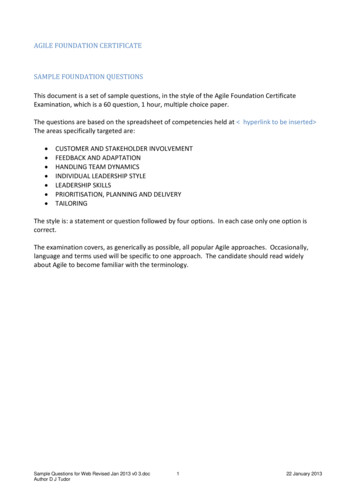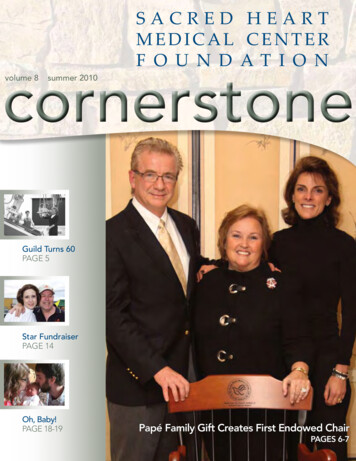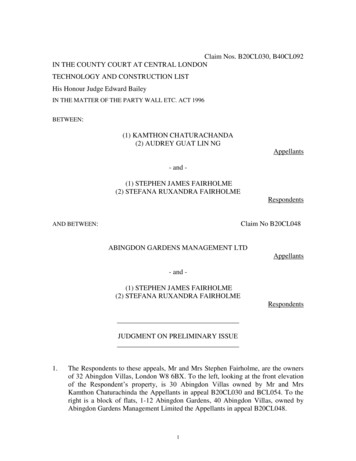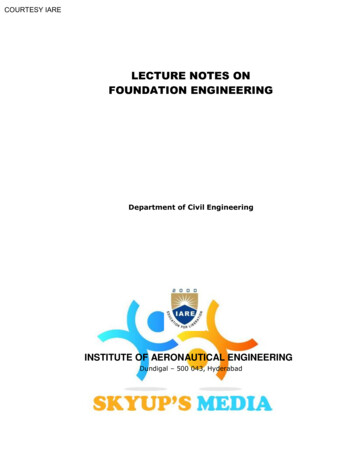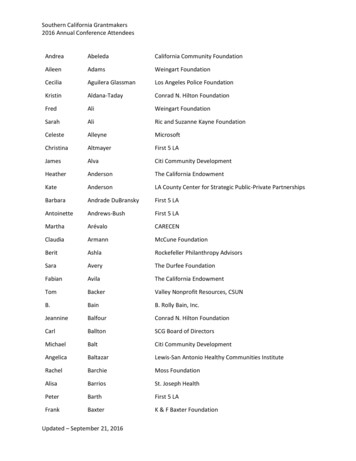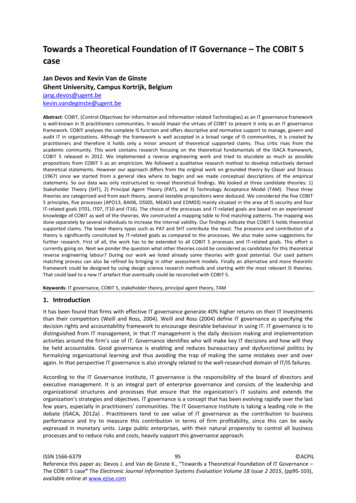
Transcription
Towards a Theoretical Foundation of IT Governance – The COBIT 5caseJan Devos and Kevin Van de GinsteGhent University, Campus Kortrijk, beAbstract: COBIT, (Control Objectives for Information and Information related Technologies) as an IT governance frameworkis well-known in IS practitioners communities. It would impair the virtues of COBIT to present it only as an IT governanceframework. COBIT analyses the complete IS function and offers descriptive and normative support to manage, govern andaudit IT in organizations. Although the framework is well accepted in a broad range of IS communities, it is created bypractitioners and therefore it holds only a minor amount of theoretical supported claims. Thus critic rises from theacademic community. This work contains research focusing on the theoretical fundamentals of the ISACA framework,COBIT 5 released in 2012. We implemented a reverse engineering work and tried to elucidate as much as possiblepropositions from COBIT 5 as an empiricism. We followed a qualitative research method to develop inductively derivedtheoretical statements. However our approach differs from the original work on grounded theory by Glaser and Strauss(1967) since we started from a general idea where to begin and we made conceptual descriptions of the empiricalstatements. So our data was only restructured to reveal theoretical findings. We looked at three candidate theories: 1)Stakeholder Theory (SHT), 2) Principal Agent Theory (PAT), and 3) Technology Acceptance Model (TAM). These threetheories are categorized and from each theory, several testable propositions were deduced. We considered the five COBIT5 principles, five processes (APO13, BAI06, DSS05, MEA03 and EDM03) mainly situated in the area of IS security and fourIT-related goals (IT01, IT07, IT10 and IT16). The choice of the processes and IT-related goals are based on an experiencedknowledge of COBIT as well of the theories. We constructed a mapping table to find matching patterns. The mapping wasdone separately by several individuals to increase the internal validity. Our findings indicate that COBIT 5 holds theoreticalsupported claims. The lower theory types such as PAT and SHT contribute the most. The presence and contribution of atheory is significantly constituted by IT-related goals as compared to the processes. We also make some suggestions forfurther research. First of all, the work has to be extended to all COBIT 5 processes and IT-related goals. This effort iscurrently going on. Next we ponder the question what other theories could be considered as candidates for this theoreticalreverse engineering labour? During our work we listed already some theories with good potential. Our used patternmatching process can also be refined by bringing in other assessment models. Finally an alternative and more theoreticframework could be designed by using design science research methods and starting with the most relevant IS theories.That could lead to a new IT artefact that eventually could be reconciled with COBIT 5.Keywords: IT governance, COBIT 5, stakeholder theory, principal agent theory, TAM1. IntroductionIt has been found that firms with effective IT governance generate 40% higher returns on their IT investmentsthan their competitors (Weill and Ross, 2004). Weill and Ross (2004) define IT governance as specifying thedecision rights and accountability framework to encourage desirable behaviour in using IT. IT governance is todistinguished from IT management, in that IT management is the daily decision making and implementationactivities around the firm’s use of IT. Governance identifies who will make key IT decisions and how will theybe held accountable. Good governance is enabling and reduces bureaucracy and dysfunctional politics byformalizing organizational learning and thus avoiding the trap of making the same mistakes over and overagain. In that perspective IT governance is also strongly related to the well-researched domain of IT/IS failures.According to the IT Governance Institute, IT governance is the responsibility of the board of directors andexecutive management. It is an integral part of enterprise governance and consists of the leadership andorganizational structures and processes that ensure that the organization’s IT sustains and extends theorganization’s strategies and objectives. IT governance is a concept that has been evolving rapidly over the lastfew years, especially in practitioners’ communities. The IT Governance Institute is taking a leading role in thedebate (ISACA, 2012a) . Practitioners tend to see value of IT governance as the contribution to businessperformance and try to measure this contribution in terms of firm profitability, since this can be easilyexpressed in monetary units. Large public enterprises, with their natural propensity to control all businessprocesses and to reduce risks and costs, heavily support this governance approach.ISSN 1566-637995 ACPILReference this paper as: Devos J. and Van de Ginste K., “Towards a Theoretical Foundation of IT Governance –The COBIT 5 case” The Electronic Journal Information Systems Evaluation Volume 18 Issue 2 2015, (pp95-103),available online at www.ejise.com
Electronic Journal Information Systems Evaluation Volume 18 Issue 2 2015COBIT, as an IT governance, management and audit framework is well-known in IS practitioners communities(ISACA 2012a). It would impair the virtues of COBIT to present it as a framework as such. COBIT analyses anddescribes the complete IS function and offers normative support to manage, govern and audit IT inorganizations (Kerr and Murthy 2013). COBIT is even used in academic programs for learning graduatestudents the principles of governing IT in organisations (Alves et al. 2012, Cabukovski and Tusevski 2011).This may sound a bit awkward, but IT academics often lag behind IT practitioners with the description,explanation and predicting of IT phenomenon’s. The latter cannot always wait for good normative theories tobuild IT artefact’s. Both communities have of course their own objectives and ways of working. Working withIT to build and implement information systems (IS) however is certainly not straightforward and a lot failuresoften darkens the blue skies predicted by IT suppliers and vendors (Avison et al. 2006, Conboy 2010, Dwivediet al. 2013). On the other hand information systems are enablers for conducting a business today. In manyindustries, survival and even existence is challenging without extensive use of information and communicationtechnology. No longer can we imagine going to work and conducting businesses without IT/IS (Laudon et al.2012). In a world of cutting-edge product development, the struggle between speed and quality is over. Speedhas won decisively. In today’s highly competitive global markets, getting innovations out quickly can mean thedifference between success and failure (Cross 2011).Although the COBIT framework is well accepted in a broad range of IS communities, it is created by and forpractitioners and therefore it holds only a minor amount of firm theoretical supported claims. Thus critic risesfrom the academic community (Ridley et al. 2008, Goldschmidt et al. 2009, Choi and Yoo 2009, Chen and Shen2010). The quest for theoretical underpinnings is not only a pure academic matter or an art pour l’art exercise,but can contribute to problems also raised by IT practitioners about COBIT. The main critic coming from thisfront is the huge amount of very complex descriptive guidelines and the strong accent on conceptualobjectives. The ‘what’ is clearly specified but not so much the ‘how’. This is good for IT auditors and riskmanagers, but clearly not so for IT managers and consultants. The authors of COBIT are well aware of theseissues and have already anticipated within COBIT with the implementation of the Single Integrated Frameworkconcept.We agree with King and Lyytinen (2004) that theory is an input to a process of getting strong results, not anoutcome. However the importance of IT/IS for organisations and society and the ever larger growing group ofIS practitioners has much to gain in researched based educational programs strongly grounded in theoreticalfoundations. We asked ourselves if COBIT does have clearly theoretical foundations that can support some ofthe claims made in the framework. We focused on the process model of COBIT as well as on the principles andIT-related goals. This work is of value to strengthen a well spread practitioners framework with the rigor of ascholarly work albeit that the course of the trajectory, first the theory and then the practice is here just theopposite. However, there is no evidence that the large group of COBIT authors, reviewers and contributorsshould not have done an excellent job and certainly made a practical and pragmatic contribution to the IT/ISfield.So to say, we implemented a reverse engineering work and try to elucidate as much as possible propositionsfrom COBIT as an empiricism. We followed a qualitative research method to develop an inductively derivedtheoretical framework. However our approach differs from the originally work on grounded theory by Glaserand Strauss (1967) since we have a general idea of where to begin and we made conceptual descriptions of theempirical statements in COBIT. So our data was only restructured to reveal theoretical findings.The paper proceeds as follows: in section two we elaborate on the COBIT framework. In section three we makea suggestion of candidate theories and give a classification of the chosen theories according to the method ofGregor (2006). Section four describes our research method and in section five we bring a discussion of ourfindings. In section six we make our conclusion and give some recommendations for further research andsome suggestions for refining our method of investigation.2. The COBIT 5 frameworkCOBIT dates back to 1996 and was originated as an IT audit framework. In 2012 a new version of COBIT 5 wasreleased (ISACA 2012a). In the rest of the paper we will use COBIT, however we did our investigation entirelywith COBIT 5. As stated before COBIT is a business framework for the governance and management ofwww.ejise.com96 ACPIL
Jan Devos and Kevin Van de Ginsteenterprise IT and is almost entirely made by IT practitioners with an appetite for IT in larger organisations,mostly in banking, insurance and consultancy. COBIT is not a scholarly work. There were academics involved inthe work of establishing the framework, but there is to the best of my knowledge no theoretical work done onthe many claims in COBIT.COBIT provides a framework that supports enterprises in achieving their objectives for the governance andmanagement of enterprise IT. COBIT is based on five key principles that embodies these objectives and enablesthe enterprise to build an effective governance and management framework that optimises IT investmentsand use for the benefit of stakeholders (ISACA 2012a). Table 1 gives an overview of the five key principles ofCOBIT.Table 1: The five key principles of COBIT1: Meeting Stakeholder Needs2. Covering the Enterprise End-to-end3. Applying a Single, Integrated Framework4. Enabling a Holistic Approach5. Separating Governance From ManagementAlthough the authors of COBIT posit that COBT is not prescriptive, it suggest a process approach for theimplementation of the framework, the COBIT Process Model (ISACA 2012b). Processes are seen as enablers orfactors that, individually and collectively, influence whether something will work for IT governance ormanagement. COBIT suggests that enablers (and thus processes) are driven by a goal cascade, i.e. higher-levelIT-related goals define what the different enablers should achieve (ISACA 2012b). There are seven categoriesof enablers in COBIT: 1) principles, policies and frameworks, 2) processes, 3) organizational structures, 4)culture, ethics and behaviour, 5) information, 6) services, infrastructure and applications, and 7) people, skillsand competencies. In this work we limited our investigation to the processes. COBIT defines a process as ‘acollection of practices influenced by the enterprise’s policies and procedures that takes inputs from a numberof sources (including other processes), manipulates the inputs and produces outputs (e.g. products, services)’(ISACA 2012a).There are generic processes for IT governance as well as for IT management. The structural overview andconsistency of the processes aims at an alignment between the business and IT (De Haes and Van Grembergen2010). COBIT is a structure of 37 processes divided in five domains. One domain is IT governance, the otherfour domains are IT management domains. Each process of COBIT has input, output, goals, key processactivities, metrics, sub processes and related references. Table 2 gives the five domains of the COBITprocesses.Table 2: Overview of the COBIT domainsDomainEvaluate, Direct and Monitor (EDM)Align, Plan and Organize (APO)Build, Acquire and Implement (BAI)Deliver, Service and Support (DSS)Monitor, Evaluate and Assess (MEA)Type of gementNumber of processes51310633. The chosen IS theoriesThe choice for candidate theories was based on the work of Truex et al. (2006) that gives fourrecommendations: 1) considering the fit between selected theory and phenomenon of interest, 2) consideringthe historical context of the theory, 3) considering how the theory impacts the choice of research method, and4) considering the contribution of theorizing to cumulative theory (Truex et al. 2006).First we selected three theories from a long list of theories used in IS research (Larsen et al. 2014) and checkedfor the Truex criteria. The chosen theories are: Stakeholder Theory (SHT), Principal Agent Theory (PAT) andTechnology Acceptance Model (TAM). In Table 3 shows an overview of the selected theories and the fulfilledrecommendations of Truex. We added the seminal papers or the theories in the bottom row of table 3.www.ejise.com97ISSN 1566-6379
Electronic Journal Information Systems Evaluation Volume 18 Issue 2 2015In this work we only choose three theories, but it is should be clear this can certainly not be a completesituation. There are so many explaining, describing and predicting IS theories. During discussion withacademics active in the field of IT governance we were attended on the Contingency Theory (CT) and thetheory of the Resource-based view (RBV) of the firm (Fiedler, 1964; Penrose, 1959). Historically, CT has soughtto formulate broad generalizations about the formal organizational structures that are typically associatedwith or best fit the use of different technologies. According to CT, business value is contingent to (i.e.dependent on) organizational factors, such as structure and environment (e.g. size). CT is an organizationaltheory and encompassed the idea that there is no best way of organizing. RBV is grounded in the economicwork on firm heterogeneity (as against market structure) in conferring above normal profits and in drivingimperfect competition. According to RBV heterogeneous firm resources are a basic for competitive advantage(i.e. differing resources, such as financial, people, know-how, etc.). RBV argues that firms possess resources,which enable them to achieve competitive advantage, and lead to superior long-term performance. RBVcontributes to an organizational theory.Table 3: The chosen theories according to the Truex criteria (Truex et al. 2006)Truex criteriaFit betweentheory andphenomenonSHTSHT fits very well with factsin COBIT. The first keyprinciple of COBIT refersalready to the broadphenomenon ofstakeholders.Historicalcontext oftheoryThe concept of stakeholderhas gradually grown fromshareholder to a generalconcept of all actors thatcould have a stake in anartefact or organisation.SHT is a process theorywhich is compliant with thebasic perspective of ourresearch method(qualitative and a mixtureof positivism andinterpretivism).SHT has been used in tenprevious works in ISresearch (Larsen et al.2014)Impact on theresearchmethodContributionto cumulativetheorySeminal paper(Frooman 1999)TheoriesPATPAT focussed on afundamental relationbetween two actors. Aninformation system is anexus of principal-agentrelations: e.g. ownermanager, user-developer,auditor-CIO, PAT is one of thecornerstone theories oforganisations.TAMA substantial critic to COBIT is the‘mechanical’ way the framework isconstructed and the ignorance of theuser as reflective human actor(Hoogervorst 2008). It makes itchallenging to investigate how TAMcould fit or not with the propositionsof COBIT.TAM is one of the only successful IStheories designed from within the ISdiscipline. Although the theory hasbeen criticized by many, currentrelevant IS research is still using TAM.PAT has two streams:positivistic agent theory andprincipal agent theory. Weconducted the last stream(Eisenhardt 1989)TAM is constructed as a variancetheory. However theoperationalization of the constructs(acceptance perceived ease of useand usefulness) can be also assessedfrom a process perspective.PAT has been used in 24previous works in ISresearch and has links withother theories used in ISresearch (Larsen et al. 2014)TAM is one of the few genuine IStheories, in the sense that the theoryis not borrowed from otherdisciplines. TAM has been used in 64previous works in IS research and hasa profound link with the DeLone &McLean Success Model (Larsen et al.2014)(Davis 1986)(Jensen and Meckling 1976)SHT is a management theory that identifies groups and individuals th at have a stake in an organisation(Frooman 1999). The theory helps to identify, understand and use in a strategic way stakeholders in anorganisation. Traditionally stakeholders where stockholders or owners of an enterprise. PAT is one of thecornerstone theories of the firm. The theory is well developed as a variance as well as a process theory. Thetheory is very well related to the theory of Transaction Cost Economics (TCE). TAM is one of most developed IStheories and brings the human interactions and perceptions in the middle. It is a theory which has his roots inpsychology but it is actually a genuine IS theory.For each of the three theories we made an analysis and a classification according to Gregor (2006) and wedeveloped a summary of components. In table 4 we show the fiche of the SHT component as an example.Similar fiches were made for PAT and TAM.www.ejise.com98 ACPIL
Jan Devos and Kevin Van de GinsteTable 4: Overview of stakeholder theoryOverview of Stakeholder Theory (SHT)SHT is a management theory that identifies groups and individuals that have a stake in an organisation (Frooman1999). The theory helps to identify, understand and use in a strategic way stakeholders in an organisation. SHTexplains how stakeholders can affect the organization. SHT gives answers to three key questions: 1) Who are thestakeholders (Mitchell et al. 1997), 2) What do the stakeholders want? and 3) How do stakeholders influence?Theory ComponentInstantiationMeans of representationWords, lists, tables and diagramsPrimary constructsQuestions, groups and individualsStatements of relationshipsRelations between the stakeholders and the organizationScopeThe relations of an organizationCausal explanationsSHT explains the relation between stakeholders and organization by stating howstakeholders will impose their will.Testable propositionsQuestions can be composted and tested by interviewsPrescriptive statementsOnly for the questions 1 and 3In summery we can consider SHT and PAT as theories for explaining, and TAM as a theory for explaining andpredicting (Gregor, 2006).4. The research methodTo assess the degree of presence of any of the three selected theories in COBIT we designed a mapping tool.This tool is based on the ideas in ISO/IEC 15504-2 (ISO/IEC 2003). We do not use the tool as an capabilitydetermination instrument but as an assessment instrument. We developed a four layered scale to score thematching of a COBIT statement, keyword or proposition with theoretical components related to the threetheories. The scale was constructed as follows Score N: (Not Present) There are no propositions, keywords or statements in COBIT that can be matchedwith components of one of the selected theories. Score P: (Present) There is a least one proposition, keyword or statement in COBIT that can be matchedwith one components of one or more of the selected theories. Score L: (Largely present) There is more than one proposition, keyword or statement in COBIT that can bematched with one theory. Score F: (Fully present) There is a strong match of several (more than two) COBIT propositions, keywordsor statements with one theory.We derived the propositions and keywords as suggested by Gregor (2006) from COBIT from three sources: 1)the five COBIT principles, 2) five selected COBIT processes (APO13, BAI06, DSS05, and MEA03) and 3) fourselected IT-related goals (goal 02 ‘IT compliance and support for business compliance with external laws andregulations’, goal 07 ‘Delivery of IT services in line with business requirements, goal 10 ‘Security ofinformation, processing infrastructure and applications’, goal 16 ‘Competent and motivated business and ITpersonnel’). We selected one IT-related goal from each dimension of the BSC (ISACA 2012b). In table 5 we givethe pattern mapping for the five selected COBIT processes, principles and IT-related goals.www.ejise.com99ISSN 1566-6379
Electronic Journal Information Systems Evaluation Volume 18 Issue 2 2015Table 5: Pattern mapping for five COBIT principles, selected processes and IT-related 1)CE-toE (2)SIF NNNNNFNLNNNNNNPNPNPNPNPNPNPNPNPNPNLNLNNNN(1) Meeting Stakeholder Needs, (2) Covering the Enterprise End-to-End, (3) Applying a Single IntegratedFramework, (4) Enabling a Holistic Approach, (5) Separating Governance From Management.5. Findings and discussionBased on the pattern mapping as shown in table 5 we brought all the mappings together in overall overviewwhich is presented in table 6. The scores are now cumulated from the previous detailed scores as shown intable 5. The scores can now be read as follows: Score N: The theory is not present. Score LP: The theory is only partly present. Only three base components of the theory are present. Score P: The theory is present and the empirical findings are within the scope of the theory and there arecausal explanations found. Score F: The theory is strongly present. There are testable propositions that can be derived or prescriptivestatements present.www.ejise.com100 ACPIL
Jan Devos and Kevin Van de GinsteTable 6: Overview of IS theories presence in COBITMeeting Stakeholder NeedsCovering the enterprise End-to-EndApplying a Single Integrated FrameworkEnabling a Holistic ApproachSeparating Governance From ManagementAPO13 Manage SecurityBAI06 Manage ChangeDSS05 Manage Security ServicesMEA03 Monitor, Evaluate and Assess Compliance with external RequirementsEDM03 Ensure Risk OptimisationIT-related Goal 02IT-related Goal 07IT-related Goal 10IT-related Goal NTAMNNNNNPPNNPNPNPThe strongest theoretical foundations in COBIT are coming for PAT. This will come as no surprise since PAT istheory that is often used to explains the elements of control in a governance versus management setting.There is also coupling in appearance between PAT and SHT. The dual appearance of PAT and SHT is remarkablein the COBIT principles. TAM is less present in COBIT. This can be due to the fact that TAM is a higher type oftheory, with strong causal relations.What we have noticed during our enquiry is that the IT-related goals can strongly determine the presence of atheory. This is the way around, a framework should be designed with a theoretical stance in the first place. Asan example: IT-related goal 07 suggest to be based on TAM and brings the theory into the process BAI06. Thesame goes for the IT-related goals 02 and 10 that bring in PAT in APO13 and DSS05. A possible explanation canbe given that when a goal is present in a process, the process is likely to be shaped to meet the goal. In thatway a possible ‘hidden’ theory is unveiled in the process. In table 7 we combined the IT-related goals with thefive selected processes. We did no go further in that direction, but this suggest a deeper investigation.Table 7: Presence of IT-related goals in the selected processes (yes present / no not present)APO10BAI06DSS05EDM03MEA03IT–related goal 02YESNOYESNOYESIT-related goal 07NOYESNONONOIT-related goal 10YESYESYESYESNOIT-related goal 16NONONONONO6. ConclusionsThe classification of IS theories and the matching with the COBIT principles, processes and IT-related goalshave shown that COBIT did not took off from a clear theoretical starting position. However the derivedtheoretical propositions from the selected theories were surprisingly present in the framework, albeit notalways completely. The primary constructs, scope and statements of relationship of the theories are oftenfound, but causal explanations are often absent. Some theories do not have very clear causal explanations, sotype I and type II theories have a higher likelihood to be supportive for COBIT. This is the case for PAT.As for the SHT we see that prescriptive statements are only limited present in COBIT. To fully implement SHTone could use the findings of Mitchell et al. (1997) to assess the influence of each stakeholder. Together withthe findings of Frooman (1999) the framework could be enriched with the way how stakeholders try toexecute their influence. This could lead to better or more fine-tuned metrics.The strong appearance of PAT and SHT in COBIT is probably due to the fact that both theories are lower typesof theories according to the classification of Gregor (2006). Also COBIT was originally build as an IT auditguideline, so control and stakeholders are key elements there.www.ejise.com101ISSN 1566-6379
Electronic Journal Information Systems Evaluation Volume 18 Issue 2 2015TAM is the less present theory of the selected theories in COBIT. To act according to TAM large changes will benecessary. We suggest a more intensified application of TAM into the COBIT processes. The ease of use andthe usefulness are such important constructs for the acceptation of technology, and this should be noticeablein COBIT. We consider it as a drawback that COBIT does not take TAM more into account. This high leveltheory has yet proofed to be very valuable.IT-related goals always suggest the presence of an IS theory. But this touches the fundamental problem ofCOBIT: what is the initiator of a descriptive of normative statement? For us, academics it should be a theoryand not a set of well agreed practical statements. However the goals cascade mechanism in COBIT forces theauthors to make causal statements, derived from the principles down to the IT-related goals. Although this acommon research practice, it is in no way supported by a theoretical context delivering theoreticalpropositions to support the deduced steps.The implicit presence of a theory in an IT-related goals, makes that the framework cannot be forced intofavourable statements. So the normative character of COBIT should come from the theories in the first place.However this means that deducing practical propositions from theories can lead to complete other goals. It isnot impossible that the stakeholders from an organization put goals in place that cannot be reached. As anexample we can take IT projects that in a traditional perspective should be managed according the old-styletrinity of constraints in budget, time and quality. However we see in reality that more than 50% of all ITprojects do not fit in such a pre-designed management model. Other theories, such as sense making (Cicmiland Hodgson 2006) and real option management (Benaroch 2002) are popping up to counter this dark side ofIT management. These theories should be much more embraced by IT practitioners communities.The generalization of our results can be an issue. We think we made a generalization from empiricalstatements to theoretical statements or a ET-generalization according to Lee and Baskerville (2003). (Lee andBaskerville 2003). This is a type of generalisation in the sense of the analytical or theoretical generalisation ofYin (2003). (Yin 2003, Dube and Pare 2003)This research has offered a positive answer to our research question if COBIT could be more founded with IStheories. However the quest to these theoretical foundations have raised a multitude of new questions. Firstof all we could ask what other theories are present in COBIT? When we disseminated this work to a limitedgroup of peers some suggestions of candidate theories pop up, such as Resource Based Theory, TransactionEconomics, and Structuration Theory. These theories, who have been used many times in IS research shouldbeen researched to see if they can contribute to this work or to a more general contribution of a cumulativetheory. Second we can pose some questions to our assessment model of scoring the presence of a theory inCOBIT. We believe that this model can be fine-tuned. Third, it is not impossible that our research method canbe of use for other practitioners frameworks which are also c
2. The COBIT 5 framework COBIT dates back to 1996 and was originated as an IT audit framework. In 2012 a new version of COBIT 5 was released (ISACA 2012a). In the rest of the paper we will use COBIT, however we did our investigation entirely with COBIT 5. As stated before COBIT is

